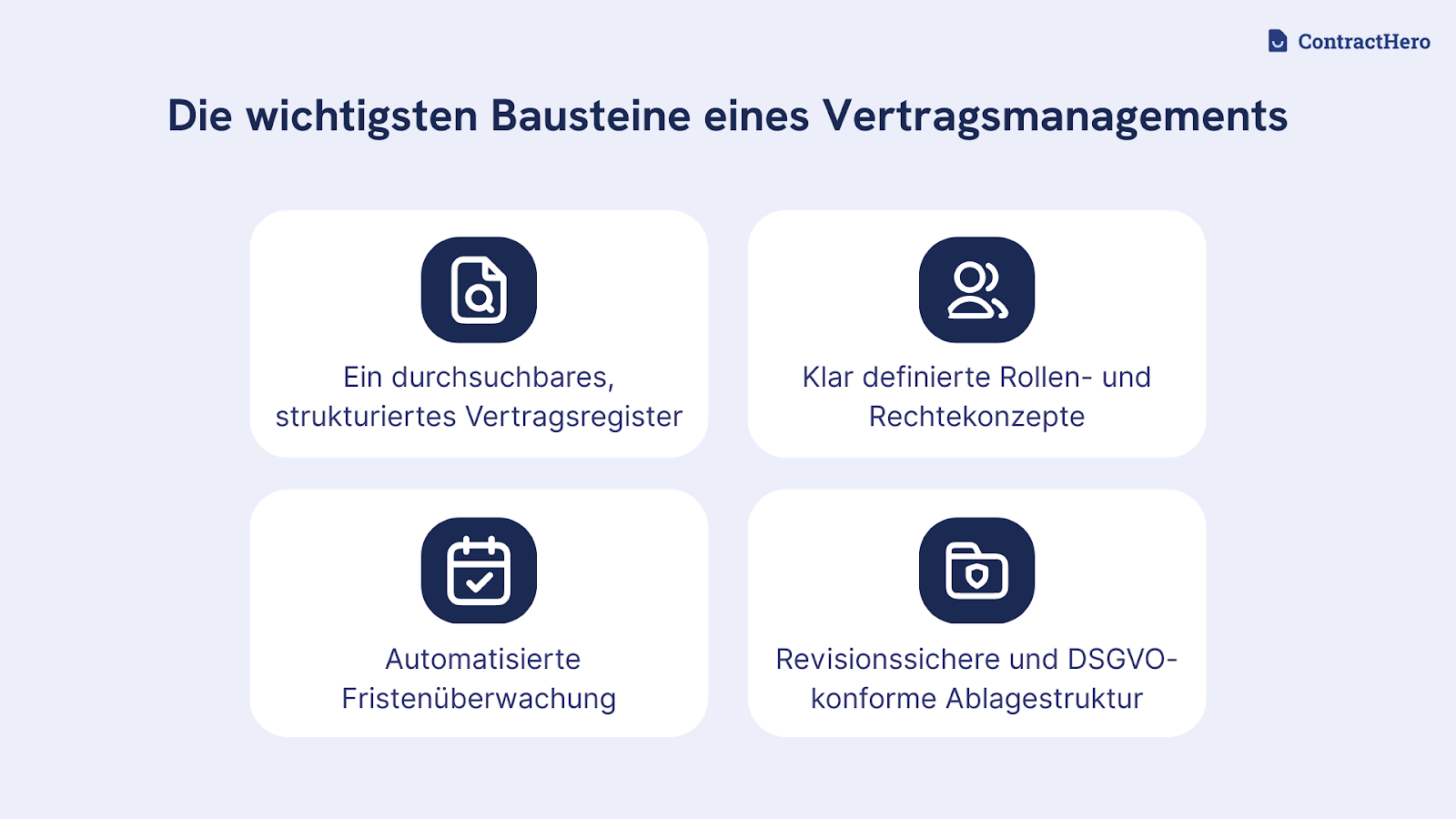
In modern companies, well thought-out contract management is considered far more than just an administrative task. It creates structure, minimizes risks and lays the foundation for efficient, scalable processes in an increasingly complex business environment. This article explains how companies can set up structured contract management step by step - supplemented by specific recommendations, practical examples and strategic insights.
If contracts are stored decentrally, named inconsistently or only filed in paper form, this often results in information silos, i.e. isolated databases that cannot be accessed or used across departments. Systematic contract management ensures that relevant contract information is centrally available, quickly retrievable, traceable and audit-proof. This leads to greater efficiency in day-to-day work and provides a reliable basis for decision-making for management and specialist departments. Automated reminder functions also significantly reduce the risk of missed deadlines. In growing organizations, a clearly structured contract process also enables better scalability and control.
A lack of contract management can have serious consequences - both organizationally and financially. Without a central overview and automated deadline monitoring, there is a risk that termination or renewal deadlines will be overlooked. Contracts may be extended automatically even though they no longer meet the current requirements or conditions. Companies run the risk of incurring unnecessary costs or losing strategic room for maneuver.
Risks also arise with regard to data protection: Contracts are often shared in unstructured repositories or via email inboxes, allowing uncontrolled access. In an emergency, this can lead to GDPR violations - with corresponding reputational and liability risks.
There is also often a lack of transparency: different versions of the same contract, undocumented changes or unclear responsibilities make tracking difficult. Manual searches for specific contract content or documents can be time-consuming and prone to error, especially during audits or under time pressure. Contract risks in particular, such as unclear payment terms, missing termination rules or outdated agreements, often remain undetected in such systems - until it is too late.
Effective contract management is based on several central components that are closely interlinked. At the center is a searchable, structured contract registerwhich makes all contract information available in one central location. This register forms the basis for transparency, efficiency and the ability to quickly provide information to internal and external stakeholders.
In addition, clearly defined role and rights concepts are necessary. These ensure that only authorized persons have access to certain documents or editing functions. This not only increases information security, but also improves the traceability of processing steps.
Another component is the automated deadline monitoring. It ensures that termination and renewal deadlines are reliably adhered to, which contributes significantly to minimizing risk when dealing with contracts. Standardized workflows also simplify the processes of contract creation, review and approval by reducing manual steps and thus shortening processing times.
Finally, a audit-proof and GDPR-compliant filing structure forms the backbone of modern contract management. It not only ensures legal security, but also supports preparation for audits or internal controls through seamless documentation and logging of all activities.

The duration of the set-up depends on the individual starting point of a company. The first visible improvements can occur after just a few weeks. These include, for example, the central storage of all contracts or the introduction of automatic deadline checks, as made possible by digital contract management systems. Comprehensive integration, including the selection of a suitable tool, interface connection and training, usually takes three to six months. A gradual roll-out - starting with individual departments or locations, for example - makes it possible to test processes, identify user requirements at an early stage and continuously optimize the introduction.
A so-called pilot area, i.e. a limited area such as a single department or location, in which the new contract management system is initially introduced on a trial basis, can provide valuable insights for the company-wide introduction - for example with regard to typical sources of error, training requirements or the adaptation of existing processes. This experience can be used to make the introduction in other areas more targeted and efficient. In addition, a staged roll-out reduces the complexity for IT and specialist departments and creates scope for accompanying communication and building acceptance within the company.

First of all, a comprehensive inventory is recommended. This involves recording all existing contracts - digital, paper-based and email-based - and filing them in a structured manner. Prioritizing particularly business-critical contract types such as rental, supplier or customer contracts makes it easier to get started. Central metadata such as terms, contractual partners or amounts should also be documented. Technical processing, for example using OCR (Optical Character Recognition) technology, can make subsequent processing considerably easier.
A successful setup is based on clearly defined goals. This can involve risk minimization, process acceleration or a better overall view. The strategic focus should be closely aligned with the company's objectives. Measurable success criteria - such as the average search time per contract, adherence to deadlines or transparency regarding contract values - enable an objective assessment of progress. Wire, a Berlin-based provider of secure business communication, provides a practical example. The average search time per contract was reduced from around ten minutes to less than 30 seconds by introducing a digital contract management system. The previously distributed and inconsistent filing system was replaced by a centralized, structured solution, which noticeably accelerated internal processes and simplified cross-team collaboration.
Growing companies in particular benefit from a scalable system. A multi-client-capable solution that also works in corporate groups or international structures is essential here. The system should also be flexibly expandable - for example with regard to the number of users, new contract types or additional locations. Automated workflows offer significant advantages for large contract volumes or in the context of M&A processes ( mergers and acquisitions).
Technical and organizational aspects must be taken into account for successful implementation. It is advisable to check the required interfaces to existing systems such as DATEV, CRM or DMS. At the same time, processes should be documented and responsibilities clearly defined. A staged roll-out - by department, for example - promotes acceptance and allows a step-by-step approach.
A functioning system requires not only technology, but also qualified users. Training should therefore be practical, short and tailored to the respective roles. Providers often support with structured onboarding processes; alternatively, internal company "champions" can take on this part. Accompanying documentation as well as support and FAQ areas contribute to a successful introduction.
A key success factor in setting up contract management lies in the definition of clear and well-documented processes. Efficiency gains and legal certainty can only be realized if all steps along the contract lifecycle - from creation, review and approval to archiving - are clearly regulated. Modern contract management systems make it possible to map this life cycle completely digitally. Manual steps are reduced, standardization is promoted and approval processes are automated. Automated approval in particular saves time and ensures greater traceability, while centrally maintained templates ensure the uniform quality and legal compliance of contracts. In addition, digital process mapping enables seamless documentation, which provides significant advantages for audits or controlling.
The success of digital contract management stands and falls with the technical foundation. Software solutions, such as ContractHero, are more than just tools for filing; they map central processes, automate routine tasks and create transparency across complex contract landscapes. Modern systems not only support administration, but also enable analysis, control and audit-proof documentation. The market offers a wide range of solutions for this - the decisive factor is what requirements the company has and how well the software integrates into existing structures.
Digital solutions offer many advantages - they are the backbone of a modern, data-supported contract organization. Companies benefit from centralized and location-independent access to all contract information, which makes day-to-day work easier, especially in distributed teams or hybrid working models. Automatic deadline reminders relieve employees of manual resubmissions and reduce the risk of critical deadlines being missed. At the same time, functions such as versioning, differentiated user rights and encryption ensure a high standard of security and guarantee compliance with legal requirements. This means that contracts are not only managed, but actively controlled and protected - with measurable added value for compliance, efficiency and collaboration.
Various factors play a role in the selection of suitable software solutions. In addition to an intuitive user interface and quick implementation, integration options with existing tools - such as Microsoft Teams, SharePoint or DATEV - are also crucial. It is equally important that the solution can be flexibly adapted to company-specific processes. Many providers today offer modular systems that can be scaled according to the maturity level and requirements of the company. Aspects such as support from the provider, regular updates and long-term development of the product should also be included in the decision-making process.
Contract data is particularly worthy of protection - the requirements for data protection and legal compliance are correspondingly high. Modern systems ensure GDPR-compliant storage, audit-proof filing and seamless logging. In addition to compliance with European data protection regulations, industry-specific compliance rules (e.g. GoBD, ISO certifications or industry-specific audit standards) are playing an increasingly important role. Systems that are regularly certified and map automated audit trails offer a clear advantage here.
The security of sensitive contract data is a top priority. Systems with end-to-end encryption and hosting in the EU - preferably in Germany - are considered the standard here. Role concepts enable targeted access control and protect confidential information. Furthermore, some solutions offer additional security functions such as two-factor authentication, IP filtering or audit trails, which are particularly necessary in regulated industries. A transparent security architecture and regular penetration tests also increase confidence in the platform.
Functioning contract management requires clear roles. For example, the legal department can be responsible for drawing up contracts, while the finance department monitors deadlines and management issues approvals. The assignment of administrator, editor and read rights should be mapped and documented in the tool. Ideally, these roles can be configured flexibly and applied to different locations, clients or companies. The possibility of substitution rules - for example in the event of vacation or absence - should also be supported in order to maintain process reliability.
In practice, it is often the lack of change management rather than the technology that leads to failure. Without clearly defined project responsibility, implementation often remains uncoordinated. An excessive focus on technical details can also be a hindrance if acceptance and training are neglected at the same time. Unclear goals, a lack of communication and overly complex tools pose additional risks.
Modern contract management is not just a filing system, but is increasingly becoming a management tool for central company departments. Those who systematically evaluate contract data can identify termination patterns, recurring payment obligations or potential for supplier bundling. These findings flow directly into budget planning, risk management and strategic decisions - and make a measurable contribution to the company's success.
ContractHero is a user-friendly contract management software that enables legal, finance and operations teams to centrally manage contracts, automatically monitor deadlines and gain valuable insights into contract data - without any complicated training. Thanks to its intuitive operation, GDPR-compliant architecture and comprehensive integration options, ContractHero is the ideal solution for anyone who wants to digitize contract processes, reduce risks and regain control.
.svg)
You may also be interested in...
.webp)
API use cases in contract management

Contract management software cloud - efficient SaaS solution
.webp)
Buy & build in private equity: Why contract management determines success and risk
.jpg)